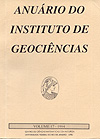Regiões fronteira no Brasil
DOI:
https://doi.org/10.11137/1994_0_53-64Abstract
Four aspects of Brazilian Frontier Regions are emphasized: - their size, being part of a country of continental dimensions; - their tropical character; - their historical role as a valve for social tensions, in a country which for long presents very strong social inequalities.different modalities of frontier-regions, those which represent the technological development, the ones which represent the advance of the ecumene, the "interior frontier regions", and the regions located on the limitis of the country. The size of the country permited for decades the movement of the frontier line to the West, the advance of the ecumene. But inside the more developed Eastern parts of the country, some enclaves of less settled territories, appear recently as "interior frontier regions". During the 19th and part of the 20th century, tropical and subtropical forested areas of the frontier were the targets for timber and crops production, while the savannas and grasslands were dedicated to cattle rising. Later an inversion occured, production of cereals, like soya beens, developed in the savannas and grasslands, while cattle occupied deforested areas of the Amazon Region. The far frontier became also an important mineral producer and attracts tourism. The frontier was, in a some extent, a subsitute for an agrarian land reform, offering conditions for social vertical mobility. More recently,however, it is loosing this function, as capital investments are directed to cattle rising, mining and timber production. Political issues deal with the social relations between incomers and old populations in the frontier regions and with the environmental questions.Downloads
Download data is not yet available.
Downloads
Published
1994-12-01
How to Cite
Geiger, P. P. (1994) “Regiões fronteira no Brasil”, Anuário do Instituto de Geociências. Rio de Janeiro, BR, 17, pp. 53–64. doi: 10.11137/1994_0_53-64.
Issue
Section
não definida
License
This journal is licensed under a Creative Commons — Attribution 4.0 International — CC BY 4.0, which permits use, distribution and reproduction in any medium, provided the original work is properly cited.















